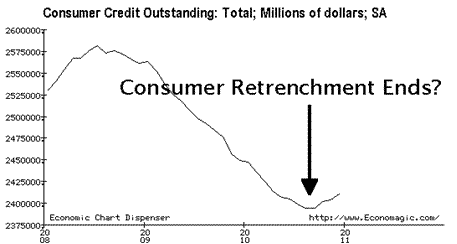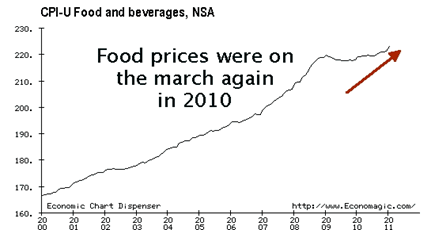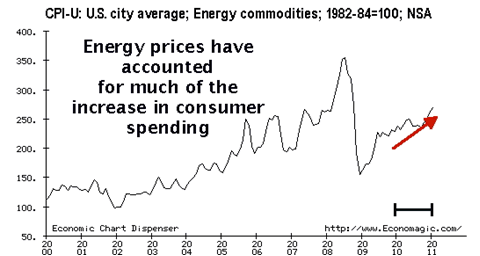The Economic Recovery that Never Was
Economics / US Economy Feb 25, 2011 - 11:00 AM GMTBy: Andy_Sutton
 It is my belief that as the headlines continue to roll in about fiscal woes from sea to shining sea that we are going to get a full appreciation for the fraud that has been perpetrated on the American people in the form of the ‘economic recovery’ that the media has been stumping for since the middle of 2009. This ‘wag the dog’ type undertaking has been about confidence, perceptions, and little else. Absolutely, there are pockets of the nation where people have found work. After all, when your government dumps nearly a trillion dollars into the economy it is going to have SOME effect. Our goal from the beginning of these hyperstimulation maneuvers was to point out the unsustainability of this course of action and more importantly to predict the consequences thereof.
It is my belief that as the headlines continue to roll in about fiscal woes from sea to shining sea that we are going to get a full appreciation for the fraud that has been perpetrated on the American people in the form of the ‘economic recovery’ that the media has been stumping for since the middle of 2009. This ‘wag the dog’ type undertaking has been about confidence, perceptions, and little else. Absolutely, there are pockets of the nation where people have found work. After all, when your government dumps nearly a trillion dollars into the economy it is going to have SOME effect. Our goal from the beginning of these hyperstimulation maneuvers was to point out the unsustainability of this course of action and more importantly to predict the consequences thereof.
Is .4% really that big of a deal?
This morning, the Commerce Department revised its GDP estimate for the fourth quarter of 2010 by .4% to the downside. That in and of itself is certainly not newsworthy, but the reasons given for the downward revision most certainly are. For the first time in quite a while, the government and the media are actually allowing the light of truth to shine into government reporting. One of the biggest reasons (which has been included in many headlines) is that cuts in state government spending are largely responsible for the cut in GDP. So what, that is common sense isn’t it? It will be, but let’s analyze. I’ve talked many times about how GDP numbers have been overstated because they included government spending that comes from borrowed money. While those discussions generally focused on the federal government, this includes the states too. The states issue debt in the form of general obligation and specific bonds to do much of their spending since they, like the federal government, are largely insolvent. This spent borrowed money counts in GDP the same as a dollar spent that had been kept in savings. The thesis proposed months ago was a simple one; the states are going into extremis and when they do, down goes GDP. Double that for the federal government.
This is one of the biggest reasons that no one in Washington really wants to cut government spending, putting the rhetoric aside. They all know that if they were to cut a trillion dollars from the federal budget that GDP would fall by around 1/14th and we’d have an instant depression. Yet at the same time, a trillion dollar cut in spending is exactly what needs to happen along with a bevy of program reforms; and that is just for starters. Hopefully this gives you a better appreciation of the predicament we’re in as a nation. This is one of the reasons I think politicians are taking up the stance that they agree cuts need to be made, but can’t agree on which ones. This will give them all political cover to maintain the status quo thereby cutting essentially nothing, while making much in the way of fanfare over insignificant token cuts. The idea of shutting down the government and its massive entitlement system has already been floated to scare people into pressuring their leaders into maintaining the status quo. Stay tuned; it gets better.
Chaste Consumers?
Consumers also did not escape blame for the lack of more vigorous ‘growth’. Spending had originally been thought to have increased at a 4.4% annualized rate. It turns out spending likely only increased at 4.1%. Bad consumers! From our good friend Jeannine at AP:
“Consumers spent a little less than first thought. Their spending rose at a rate of 4.1 percent, slightly smaller than the initial estimate of 4.4 percent. Still, it was the best showing since 2006. And it suggests Americans will play a larger role this year in helping the economy grow, especially with more money from a Social Security tax cut.”
Talk about opinion shaping. This should be another indicator that nobody is really intent on fixing anything. While I am all in favor of a tax cut, one without reform seems rather obtuse, especially given the fact that Social Security is already in the red and busted out beyond description in terms of its unfunded promises. The program needs a massive overhaul, not insipid palliatives.
What cannot be left alone in the above press line is the suggestion that consumers are going to lift the economy in such a Herculean manner. First of all, let’s get it straight that much of the ‘gain’ in consumer spending (as measured by retail sales) came from the fact that consumers are paying more for food and gasoline and, sadly, have increased their debt burdens slightly to do so. More unsustainability.
To demonstrate this, I’ll show a couple of charts; the first is the slight, but significant increase in consumer credit followed by the steady increases in both food and energy prices throughout all of 2010:

Now let’s get a better idea of where at least a portion of those borrowed dollars went – first food and beverage prices:

Now, for energy…

Consumers paying more for staple goods doesn’t constitute economic growth, yet this is exactly what the Keynesian deficit-lovers would have you believe. And we know the CPI is in most cases grossly understating the real increases, but at least you now have a visualization of the issue. It may very well be that this next boom in consumer indebtedness comes more from necessity rather than greed and avarice. With the labor market still incredibly soft, and thousands of discouraged workers falling out of the BLS counts each month, the credit card is the only place many people will be able to fill the gap.
Further anecdotal evidence that supports the notion that this ‘recovery’ was nearly entirely a contrived event (thanks to borrowed government money and increasing prices of finished goods) is the housing market. Home prices have continued to drop despite the frantic calls of ‘bottom’ from market analysts, hopeful professional associations like NAR, and the mainstream press. Foreclosures continue to mount and even CNBC got on the bandwagon a few weeks back reporting that around 11% of all homes in the US are now sitting empty. A genuine bottom up fix would have corrected many of these problems. Spending a trillion dollars to rebuild our manufacturing base would have created jobs beyond those necessary to do the building. It would have employed people on an ongoing basis, miraculously converting bad debts into good ones. Instead we chose to do a top-down fix, lavishing trillions of dollars on banks, brokerages, and lobbyists in the hope that a few bucks might find their way to Joe Q. Public. It reeks of too much textbook and too little practicality.
The recovery that never was is over. Continuation of the current state of affairs will result in further debt accumulation by a system that is ready to disintegrate on its own weight. Assuming the consumer can step in and spend up where even state governments leave off is an absurd idea. Assuming they can fill the black hole left by a gutted and fiscally impotent federal government is laughable.
By Andy Sutton
http://www.my2centsonline.com
Andy Sutton holds a MBA with Honors in Economics from Moravian College and is a member of Omicron Delta Epsilon International Honor Society in Economics. His firm, Sutton & Associates, LLC currently provides financial planning services to a growing book of clients using a conservative approach aimed at accumulating high quality, income producing assets while providing protection against a falling dollar. For more information visit www.suttonfinance.net
Andy Sutton Archive |
© 2005-2022 http://www.MarketOracle.co.uk - The Market Oracle is a FREE Daily Financial Markets Analysis & Forecasting online publication.



